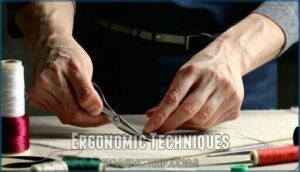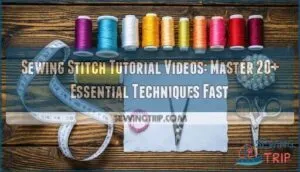This site is supported by our readers. We may earn a commission, at no cost to you, if you purchase through links.
 When you learn how to hold sewing scissors correctly, you’ll cut fabric like a pro.
When you learn how to hold sewing scissors correctly, you’ll cut fabric like a pro.
Put your thumb through the smaller hole and your middle finger through the larger one. Rest your index finger on the outside of the blade for better control.
Keep your wrist straight and relaxed. This grip helps you make clean, straight cuts without getting tired hands.
The scissors should feel balanced in your hand, not heavy or awkward. Don’t squeeze too hard or your hand will cramp up. Let the sharp blades do the work for you.
Once you master this basic grip, there are special techniques for different cutting situations, and you’ll be able to make clean, straight cuts without difficulty, using your newfound skill to cut fabric like a pro.
Table Of Contents
Key Takeaways
- Put your thumb through the smaller hole and middle finger through the larger one, with your index finger resting on the outside of the blade for better control and balance.
- Keep your wrist straight and maintain a relaxed grip – don’t squeeze too hard or you’ll cramp up, and let the sharp blades do the work instead of forcing cuts.
- Use your sewing scissors only for fabric to keep them sharp and effective – cutting paper, cardboard, or plastic will dull the blades and reduce their effectiveness.
- Hold the scissors at a slight downward angle perpendicular to the fabric while cutting away from your body to ensure clean cuts and maintain safety.
Proper Holding of Sewing Scissors
You’ll hold your sewing scissors correctly by putting your thumb in the smaller hole and your index and middle fingers in the larger hole.
Keep your ring finger and pinky tucked into your palm, and make sure the top blade lines up with your dominant hand for the best control, which involves holding the scissors so that the top blade is aligned with your dominant hand.
Grip Technique
Perfect sewing scissors grip starts with understanding your tool’s anatomy. Your scissors holding technique determines cutting success and comfort during long sewing sessions.
Master these essential grip fundamentals:
- Finger Placement – Insert your thumb in the smaller ring, middle finger in the larger one
- Thumb Position – Keep your thumb slightly bent, not fully extended or cramped
- Handle Alignment – Position handles parallel to each other for balanced control
- Grip Pressure – Hold firmly but relaxed, like shaking hands with a friend
This ergonomic scissors grip prevents fatigue while ensuring precision cuts. To maintain peak performance, consider regular blade sharpening.
Hand Positioning
Proper finger placement starts with your thumb in the smaller ring and your middle finger in the larger one.
Your thumb position should feel natural, not strained or twisted.
Handle alignment matters – keep both rings facing the same direction for better control.
Grip pressure should be firm but relaxed, like holding a bird.
Make comfort adjustments by shifting your hand position until the scissors hand position feels right.
This scissors holding technique prevents fatigue during long cutting sessions.
Scissor Usage and Care
You’ll keep your sewing scissors sharp and working well when you use them only for fabric and avoid cutting paper or other materials.
Taking care of your scissors means they’ll cut smoothly for many years and won’t get dull or damaged from the wrong kind of use, which helps them work well.
Repurposing Plastic Scissors
Give those worn plastic scissors a second life by dedicating them to paper cutting and craft projects.
This smart move keeps your premium fabric shears razor-sharp while extending your tool’s usefulness.
Set up a designated craft station where kids can safely tackle school projects with these repurposed scissors.
The blunt edges make them perfect for young crafters learning proper scissor grip and handling techniques.
You’ll love having dedicated scissors for cutting plastic materials without worrying about dulling your expensive fabric tools, and enjoying the benefits of proper scissor grip and craft projects.
Avoiding Non-Fabric Materials
Your fabric scissors weren’t meant to tackle cardboard or plastic.
Your precious fabric shears deserve better than paper cuts—save them for what they do best.
Material hardness plays a vital role in blade preservation.
When you use scissors for cutting fabric exclusively, you maintain cutting efficiency and guarantee tool longevity.
Paper contains abrasive fibers that quickly dull precision edges.
Proper scissor handling means keeping dedicated sewing scissors away from non-fabric materials.
This damage prevention strategy protects your investment.
Your fabric scissors technique should focus on textiles only, preserving their sharp performance for years.
To avoid dulling, remember that blade damage is possible.
Consequences of Improper Usage
Using your sewing scissors on paper, cardboard, or plastic leads to serious blade damage and blunting scissors faster than you’d expect.
This material damage creates reduced effectiveness when cutting fabric, forcing you to apply more pressure.
The extra effort causes hand fatigue and hand pain during long sewing sessions.
Poor scissors control from dull blades increases injury risk.
Proper scissor handling means respecting what your tools were designed to cut, which is essential for maintaining scissors effectiveness and safety.
Sharpening Metal Scissors
Sharp scissors make all the difference in your sewing projects. You should sharpen your metal scissors every 12-18 months depending on usage frequency.
Use sharpening tools like whetstones or dedicated scissor sharpeners, maintaining a 60-75 degree angle for best results. Professional sharpening services handle expensive scissors best.
After sharpening, remove any burr with light strokes. Clean scissors blades regularly and apply scissor lubrication to the pivot point.
Proper scissor maintenance keeps your cutting tools performing like new for years of precise sewing work. You can also try sharpening scissors sandpaper as a convenient method.
Ergonomic Techniques
You can prevent hand pain and reduce tiredness by learning the right way to hold your sewing scissors.
These simple ergonomic methods will help you cut fabric for longer periods without your hands getting sore or tired.
Preventing Hand Pain
Hand pain while cutting fabric doesn’t have to be your reality. A relaxed grip prevents strain better than white-knuckling your scissors.
Choose tools with padded handles and spring assistance to reduce effort. Proper size matters—scissors should fit your hand comfortably.
Consider using ergonomic sewing tools to alleviate discomfort.
Here are five ways to maintain hand comfort:
- Practice finger exercises between cutting sessions
- Select scissors with ergonomic grip designs
- Take regular breaks during long projects
- Maintain loose, controlled scissor grip
- Invest in quality tools that reduce hand fatigue
Reducing Hand Fatigue
Smart sewers know that reducing hand fatigue starts with mastering your scissor grip. A relaxed grip prevents muscle strain during long cutting sessions.
Choose scissors with padded handles and spring-loaded blades for comfort. Proper size matters – your hand should fit naturally without stretching.
Practice finger exercises between cuts to maintain flexibility. Consider investing in ergonomic scissor options to further reduce strain.
| Fatigue Fighter | How It Helps |
|---|---|
| Relaxed Grip | Reduces muscle tension |
| Ergonomic Grip | Fits hand naturally |
| Comfortable Scissor Hold | Prevents cramping |
| Proper Hand Position | Maintains control |
| Spring-Loaded Action | Minimizes effort |
Using a Cutting Mat
Beyond reducing hand fatigue, a quality cutting mat transforms your sewing workspace into a precision cutting station.
The right mat material makes all the difference – self-healing mats repair themselves after each cut, extending their lifespan substantially. When selecting mat size, consider your largest fabric pieces and available workspace. Mat thickness affects stability, with thicker options providing better blade protection. Many sewers purchase self-healing cutting mats to protect their tables. Mat thickness affects stability, with thicker options providing better blade protection.
Here’s how cutting mats enhance your sewing scissors performance:
- Surface Protection – Protecting surfaces prevents blade dulling from hard countertops
- Grid Guidance – Measurement lines guarantee straight, accurate cuts every time
- Blade Preservation – Soft surfaces maintain sharp edges longer than wood or glass
- Grip Stability – Non-slip backing keeps fabric positioned while you maintain proper grip
Your cutting techniques improve dramatically when scissors grip meets supportive surface technology.
Advanced Cutting Techniques
Once you’ve mastered basic scissor holding techniques, you can learn special methods that make cutting faster and more accurate.
These advanced skills help you handle long fabric pieces and use different types of cutting tools with better control.
Cutting Long Pieces
When cutting long fabric pieces, your success depends on mastering continuous motion and proper blade angle.
Loosen your grip slightly to let the scissors glide naturally through the material.
Use the full blade length for smooth cuts instead of making small choppy motions.
Keep your fabric manipulation steady while maintaining a consistent cutting angle.
This technique improves cutting efficiency and reduces hand strain.
Your proper grip combined with flowing movements creates clean edges on lengthy pieces.
Practice this method with scraps first to build confidence before tackling important sewing projects, focusing on smooth cuts.
Spring-Action Thread Snips
Spring-action thread snips bring speed and precision to your sewing projects.
These specialized sewing tools work like tiny scissors with built-in springs that automatically reopen after each cut. You’ll find them perfect for quick thread trimming and detail work.
Here’s why spring-action snips excel:
- Swift cuts happen with minimal hand movement
- Precise cuts thanks to sharp, pointed blades
- Blade sharpness stays consistent with proper care
- Tweezer-like grip gives you excellent control
- Compact size makes them essential sewing scissors for tight spaces
For those seeking the best thread snippers, ergonomic handles are key for comfort.
Holding Thread Snips
When you pick up thread snips, hold them like tweezers between your thumb and index finger.
This tweezer-like grip gives you the control needed for precise cuts on delicate threads.
Position your fingers near the pivot point for better leverage and comfort.
The spring action mechanism does most of the work, so you don’t need to squeeze hard.
Adjust the angle of the snips to match your cutting needs – this angle adjustment helps you reach tight spaces around your sewing project.
With prolonged reach capabilities, these sewing tools let you trim threads without repositioning your fabric constantly.
Master this scissors grip technique, and you’ll handle all your sewing scissors with confidence.
Benefits Technique
Safety and Travel Considerations
When you’re traveling with sewing scissors, you need to pack them safely to protect yourself and others from the sharp blades.
You’ll also need to follow airport rules and learn the right way to carry scissors without getting hurt, which involves understanding the complete concepts of safety and regulation.
Packing Scissors for Travel
Traveling with your favorite sewing scissors requires careful planning to keep everyone safe. Sharp tools can cause serious injuries if they’re not packed properly.
Here’s how to pack your scissors for safe travels:
- Wrap blade tips in thick cardboard or fabric sheaths to prevent cuts during handling
- Place scissors in hard cases to protect them from damage and keep handlers safe
- Label your scissor storage clearly so baggage handlers know sharp tools are inside
- Research airline regulations before packing since rules vary between different carriers
For checked baggage, secure packing protects your scissors and prevents handler safety issues.
International travel may have different scissor safety requirements, so check destination rules.
Proper scissors transportation means everyone stays safe while your tools arrive ready to work.
Airport Security Regulations
When traveling with scissors, you need to follow TSA Guidelines for smooth passage through security.
Scissors with blades under 4 inches from the pivot point meet Carry-on Rules for domestic flights.
For International Travel, research destination regulations as rules vary by country.
Pack larger scissors in Checked Baggage with Secure Packing methods.
Wrap blades in protective sheaths to guarantee scissors safety during transport and prevent damage to your luggage.
Preventing Injury to Handlers
When packing scissors for travel, your careful handling protects baggage workers who face injury risks daily.
Secure storage in hard cases or blade sheaths prevents accidental cuts during luggage processing.
Wrap sharp tooling in thick cloth before placing in checked bags.
Proper blade inspection guarantees no loose parts that could harm handlers.
To keep these fabrics in good condition, consider pH neutral detergents when cleaning.
These scissors safety measures reduce workplace injuries while maintaining your tools’ condition through responsible workspace maintenance practices, ensuring proper blade inspection and promoting careful handling.
Additional Safety Tips
Beyond proper handling, smart safety habits keep you and others protected.
Workspace safety starts with regular blade inspection to catch damage early. Child supervision becomes non-negotiable when little hands are around sharp tools.
- Store scissors in secure storage areas away from children’s reach
- Choose safety scissors with blunt tips for young crafters
- Follow scissors best practices by keeping blades closed when not cutting
- Remember scissors warnings about carrying them properly—tips down, blades together, to ensure proper handling
Frequently Asked Questions (FAQs)
How do you use scissors?
Insert your thumb in the smaller hole and fingers in the larger one.
Hold blades perpendicular to material, keep them pointed away from your body, and cut with smooth motions for clean results.
How do you Hold Your sewing scissors?
Like finding the perfect handshake, you’ll slip your thumb through the smaller ring and middle finger through the larger one.
Keep your grip relaxed, blades angled downward, and always cut away from your body for safety.
How do you use a left-handed scissors?
You’ll insert your thumb into the right hole and fingers into the left hole, opposite of right-handed scissors.
The top blade sits on your left side, giving you better visibility and control while cutting.
How do you hold a scissors if you’re not holding them?
When you’re not actively cutting, close the scissor blades completely and point the tips downward. Wrap your fingers around the closed blades to prevent accidental opening and carry them safely.
Can a left-handed person hold sewing scissors?
You’ll want left-handed scissors though – regular ones make your hand work against the blade angle. Left-handed scissors have mirrored blades that align with your natural cutting motion and grip.
How do you use a hand to cut with scissors?
Insert your thumb into the smaller ring and your index finger into the larger ring.
Keep your other fingers curled in your palm.
Squeeze the handles together to close the blades and cut.
Is There a Specific Angle at Which the Scissors Should Be Held for the Most Efficient Cutting?
Hold your scissors at a slight downward angle, keeping them perpendicular to the fabric.
This position gives you better control and creates cleaner cuts while reducing hand strain during extended cutting sessions.
Is there a specific angle at which the scissors should be held for the most efficient cutting?
Most sewers unknowingly lose 30% cutting efficiency through poor scissor angles.
You’ll achieve ideal results by angling your scissors slightly downward while keeping blades perpendicular to fabric, ensuring smooth cuts without hand strain.
This will help in maintaining the overall efficiency and reducing hand strain.
What size scissors work best for beginners?
For beginners, 8-inch fabric scissors offer the perfect balance of control and cutting power.
They’re manageable for small hands yet efficient for most sewing projects.
You’ll find them comfortable without being overwhelming, making them a great choice for those new to sewing with scissors.
How often should scissors be professionally serviced?
Seventy percent of scissor problems stem from dull blades.
You should professionally service your sewing scissors every one to two years, depending on usage frequency.
Heavy daily cutting requires annual sharpening, while occasional use extends service intervals longer.
Conclusion
Sharp blades paired with clumsy hands create frustration, while proper technique transforms every cut into precision.
Mastering how to hold sewing scissors correctly makes the difference between amateur struggles and professional results.
Your thumb and middle finger work together through the holes while your index finger guides each cut.
Keep your wrist straight and let the scissors do the work.
With practice, you’ll develop muscle memory that makes clean cuts feel natural and effortless every time.
- https://proshearus.com/blogs/news/what-are-the-best-techniques-for-using-sewing-scissors-efficiently
- https://www.fiskars.com/en-us/customer-service/faqs
- https://services.flexco.com/how-to-hold-scissors/
- https://www.nationalsewingcircle.com/video/how-to-hold-scissors-to-reduce-hand-fatigue-009653/
- https://www.iwh.on.ca/sites/iwh/files/iwh/tools/ergo_handbook_clothing_2001.pdf















